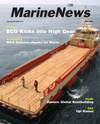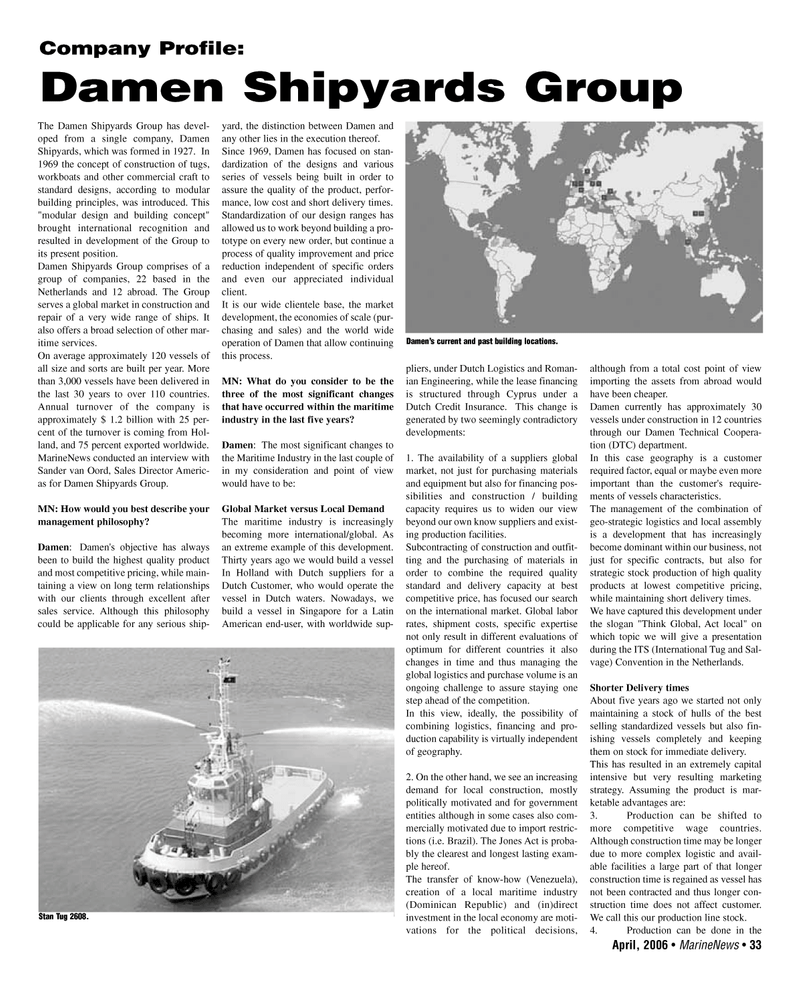
Page 33: of Marine News Magazine (April 2006)
Offshore Support
Read this page in Pdf, Flash or Html5 edition of April 2006 Marine News Magazine
The Damen Shipyards Group has devel- oped from a single company, Damen
Shipyards, which was formed in 1927. In 1969 the concept of construction of tugs, workboats and other commercial craft to standard designs, according to modular building principles, was introduced. This "modular design and building concept" brought international recognition and resulted in development of the Group to its present position.
Damen Shipyards Group comprises of a group of companies, 22 based in the
Netherlands and 12 abroad. The Group serves a global market in construction and repair of a very wide range of ships. It also offers a broad selection of other mar- itime services.
On average approximately 120 vessels of all size and sorts are built per year. More than 3,000 vessels have been delivered in the last 30 years to over 110 countries.
Annual turnover of the company is approximately $ 1.2 billion with 25 per- cent of the turnover is coming from Hol- land, and 75 percent exported worldwide.
MarineNews conducted an interview with
Sander van Oord, Sales Director Americ- as for Damen Shipyards Group.
MN: How would you best describe your management philosophy?
Damen: Damen's objective has always been to build the highest quality product and most competitive pricing, while main- taining a view on long term relationships with our clients through excellent after sales service. Although this philosophy could be applicable for any serious ship- yard, the distinction between Damen and any other lies in the execution thereof.
Since 1969, Damen has focused on stan- dardization of the designs and various series of vessels being built in order to assure the quality of the product, perfor- mance, low cost and short delivery times.
Standardization of our design ranges has allowed us to work beyond building a pro- totype on every new order, but continue a process of quality improvement and price reduction independent of specific orders and even our appreciated individual client.
It is our wide clientele base, the market development, the economies of scale (pur- chasing and sales) and the world wide operation of Damen that allow continuing this process.
MN: What do you consider to be the three of the most significant changes that have occurred within the maritime industry in the last five years?
Damen: The most significant changes to the Maritime Industry in the last couple of in my consideration and point of view would have to be:
Global Market versus Local Demand
The maritime industry is increasingly becoming more international/global. As an extreme example of this development.
Thirty years ago we would build a vessel
In Holland with Dutch suppliers for a
Dutch Customer, who would operate the vessel in Dutch waters. Nowadays, we build a vessel in Singapore for a Latin
American end-user, with worldwide sup- pliers, under Dutch Logistics and Roman- ian Engineering, while the lease financing is structured through Cyprus under a
Dutch Credit Insurance. This change is generated by two seemingly contradictory developments: 1. The availability of a suppliers global market, not just for purchasing materials and equipment but also for financing pos- sibilities and construction / building capacity requires us to widen our view beyond our own know suppliers and exist- ing production facilities.
Subcontracting of construction and outfit- ting and the purchasing of materials in order to combine the required quality standard and delivery capacity at best competitive price, has focused our search on the international market. Global labor rates, shipment costs, specific expertise not only result in different evaluations of optimum for different countries it also changes in time and thus managing the global logistics and purchase volume is an ongoing challenge to assure staying one step ahead of the competition.
In this view, ideally, the possibility of combining logistics, financing and pro- duction capability is virtually independent of geography. 2. On the other hand, we see an increasing demand for local construction, mostly politically motivated and for government entities although in some cases also com- mercially motivated due to import restric- tions (i.e. Brazil). The Jones Act is proba- bly the clearest and longest lasting exam- ple hereof.
The transfer of know-how (Venezuela), creation of a local maritime industry (Dominican Republic) and (in)direct investment in the local economy are moti- vations for the political decisions, although from a total cost point of view importing the assets from abroad would have been cheaper.
Damen currently has approximately 30 vessels under construction in 12 countries through our Damen Technical Coopera- tion (DTC) department.
In this case geography is a customer required factor, equal or maybe even more important than the customer's require- ments of vessels characteristics.
The management of the combination of geo-strategic logistics and local assembly is a development that has increasingly become dominant within our business, not just for specific contracts, but also for strategic stock production of high quality products at lowest competitive pricing, while maintaining short delivery times.
We have captured this development under the slogan "Think Global, Act local" on which topic we will give a presentation during the ITS (International Tug and Sal- vage) Convention in the Netherlands.
Shorter Delivery times
About five years ago we started not only maintaining a stock of hulls of the best selling standardized vessels but also fin- ishing vessels completely and keeping them on stock for immediate delivery.
This has resulted in an extremely capital intensive but very resulting marketing strategy. Assuming the product is mar- ketable advantages are: 3. Production can be shifted to more competitive wage countries.
Although construction time may be longer due to more complex logistic and avail- able facilities a large part of that longer construction time is regained as vessel has not been contracted and thus longer con- struction time does not affect customer.
We call this our production line stock. 4. Production can be done in the
April, 2006 • MarineNews 33
Company Profile:
Damen Shipyards Group
Damen’s current and past building locations.
Stan Tug 2608.
APRIL MN2006 5(33-40).qxd 4/7/2006 3:11 PM Page 33

 32
32

 34
34
